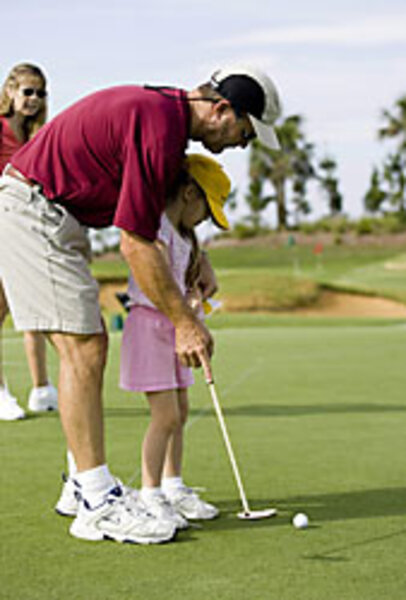These days, golf is becoming a family affair
Loading...
At Bill Allen's junior golf classes at the North Hill Country Club in Duxbury, Mass., kids as young as 5 learn how to hit a ball out of a sand trap and to remove tee marks from the grass. On a recent Monday, as a group of mothers stood watching, a few commented on how their children's involvement in the game has spurred their own.
"My kids started playing golf because it's my husband's passion," says Carolyn Loiselle, the mother of an 8-year-old daughter and 6-year-old son. "Then I said, 'If the three of you are going to play, I'm not going to be left out.' "
Ms. Loiselle, along with many of the other young golfers' moms, signed up for one of the women's golf camps Mr. Allen began offering last fall. The response to the camps so far has been overwhelming; each has sold out, so he has continued adding new ones.
The "golf widow" image of old – the woman left at home while her husband heads out to the course – has started to fade, Allen says, particularly as more kids are showing interest in the sport. "Women are saying, 'it's my turn to start.' "
Allen's experience would seem welcome news for the golf industry, as much has been made of the sport's decline in recent years. According to the National Golf Foundation (NGF), the number of golfers has remained flat for the past five or six years, while the number of frequent or "core" golfers has fallen. Changing family obligations have been fingered as one reason, as fathers shoulder more household responsibilities than they did a few decades ago.
"It used to be that men would spend a Saturday or a Sunday on the golf course, but now that's the time to be with their families," says Richard Rocchio, former New York regional director of the National Golf Course Owners Association. "The thing I hear a lot now is that men have to take kids to soccer practice or lacrosse practice."
Not surprisingly, preeminent golf associations have responded by reaching out to families. Since 2006, the Professional Golfers' Association of America (PGA) has designated July as "Family Golf Month," with participating courses around the country offering special programs and rates for parents and kids. Since 2000, the National Golf Course Owners Association has hosted an annual "Take Your Daughter to the Course Week," with free lessons and rounds for girls with a paying adult.
"[Golf organizations] are beginning to recognize that the family unit is very, very important and that they're a little late in recognizing that," Mr. Rocchio says. "Kids' sports are taking a big bite of parents' time.... Getting kids involved in golf is important. It'll happen, but it'll be a slow process."
According to a recent NGF survey, 60 percent of private golf clubs had implemented some type of program to enhance their appeal to families. At the PGA Golf Club in Port St. Lucie, Fla., professional Bob Baldassari recently implemented a flexible pricing system that allows golfers and their kids to play as few holes as they'd like. Many children do not have the attention span or the stamina for 18 or even nine holes, he says.
"Even if you play one hole, you can say, 'I played golf today,' " says Mr. Baldassari. "I'd rather get parents and their kids in five times a month playing one hole than one time every six weeks for 18 holes."
Other courses have begun setting aside times for families to play together free of charge. For two months in the summer, families at the Santa Teresa Golf Club in San Jose, Calif., can play without cost 90 minutes before dark. The special, offered four evenings a week, has succeeded in encouraging people "who generally wouldn't make it out on the course to give [golf] a try and see that they like it," says Dave Elliott, a pro at the club.
Innisbrook Resort and Golf Club near Tampa, Fla., opened a nine-hole, 850-yard walking course in May. The idea was to offer a less intimidating option to novice golfers and nongolfers – generally wives and children – than the resort's elite courses, says Ramona Hurley, an Innisbrook spokesperson.
"In some cases, men will go out on one of the championship courses in the morning and go to the walking course with their families in the afternoon," she says. The resort also offers free lessons to guests.
If successful, such programs might build upon the gains golf has made among kids. In 2006, 4.8 million youngsters played at least one round, compared with 4.4 million in 2005, according to the NGF's most recent golf participation report. This year Allen is teaching one-third more youngsters than last. Some, including Allen, credit Tiger Woods with boosting golf's image among youth. Others say golf is a welcome alternative to more competitive team sports.
"It's really nice because it's so individual," says Sarah Stinebiser, whose two sons and daughter – ages 8, 10, and 13 – are all Allen's students. "There's a lot of pressure with sports like baseball and hockey, and kids can get so nervous and stressed."
Genny Reynolds, one of the moms who signed up for Allen's camps after her two children began taking lessons, says playing golf with her family has been rewarding. "It's exercise, it's keeping fit, it's something that everyone can do, at all levels," she says. "Plus, as you get older, it's harder to spend time with your kids. You can golf with them when you're 80."





